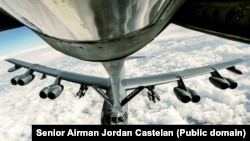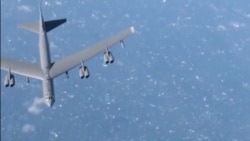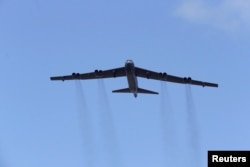(Editor’s note: This is an update of our story originally published March 23, with new information from an open source researcher, who disputes some of the U.S. Air Force information, but also the conclusion of the Russian Defense Ministry and particularly TASS, a Russian state media outlet.
The additions are in a new section of the article under the heading “Open Source Flight Information.” We find there is not enough new information to change our verdict).
On Thursday, March 21, the Russian state news agency TASS, citing Russia’s Defense Ministry, reported that two Russian Sukhoi-27 jets had "forced" a U.S. B-52 bomber flying over the Baltic Sea to “move away” from the Russian border.
The article, headlined “Two Sukhoi jets chase US B-52 bomber away from Russian border,” reported that the strategic bomber, which was flying over international waters, was “far away from the border” at the time of the incident and put “under observation”.
The report said that after the Sukhoi-27s were scrambled to escort the aircraft, the B-52 “changed course to move away from the Russian state border.”
Afterwards, the Russian jets reportedly returned to base.
Meanwhile, a statement posted by the Russian Defense Ministry on Facebook never said the B-52 was “forced” to move way from Russia, rather claiming that the two Russian fighter jets were scrambled to “identify” and “directly escort” the strategic U.S. bomber.
The Russian Defense Ministry statement noted the target was detected “at a considerable distance from the state border of the Russian Federation.”
On Twitter, Russia’s Defense Ministry pinned a Russian-language tweet of the alleged flight “escort” video to its page, while the clip was tweeted in numerous languages, including Arabic, English, French and Spanish.
The date of the encounter is not specified.
Lt. Col. Davina Petermann of the U.S. Air Forces in Europe – Air Forces Africa Public Affairs Office told Polygraph.info that U.S. Air Force B-52 Stratofortresses were conducting training flights on March 20 in the Baltics and Poland “as a clear and visible demonstration of U.S. commitment to regional security.”
Petermann said while a U.S. B-52 was exercising its “freedom of navigation and overflight” in international airspace, it had “a routine interaction with a Russian Su-27 while conducting operations over the Baltic Sea.”
She said the B-52 pilots were using their transponders and operating in line with international law.
“The Russian aircraft did not chase the B-52 away, and the bomber was able to complete its mission,” Petermann said, adding “operations and engagements with our allies and partners demonstrate and strengthen our shared commitment to global security and stability.
Petermann affirmed the B-52 was not diverted from Russia’s borders, nor was its course changed, as a result of that "routine interaction," reiterating it “was able to complete its mission as scheduled.”
The B-52s conducted flights from RAF Fairford, England, to Lithuania and Poland for the purposes of “interoperability training with NATO Enhanced Forward Presence units,” a U.S. Air Force press release read.
According to that statement, the B-52s conducted training with NATO Joint Terminal Attack Controllers attached to the multinational battalion battle group in Lithuania and Battle Group Poland.
“In Lithuania, the B-52s dropped inert munitions and integrated into Close Air Support training alongside Lithuanian L-39 Albatros high-performance training jets,” the statement read.
The bombers arrived in the area on March 14-16.
The statement continued that operating out of forward locations “enables collective defense capabilities and provide the U.S. and NATO the strategic and operational breadth needed to deter adversaries and assure our allies and partners.”
Open Source Flight Information
Steffan Watkins, a Canadian IT security consultant and open source intelligence enthusiast, however, disputes portions of the U.S. Air Force’s account. He also disputes Russia’s conclusions.
Watkins said that on the day of the intercept, his reading of open source flight trackers indicated that one of the two American planes which flew in formation over the Baltic Sea were using transponders.
Watkins said that while the Russian Su-27s photographed the American B-52 numbered 61-0013, “there was another with their transponder on, not photographed, that shows up as 60-0061 (which it is not),” he told Polygraph.info.
“The lead plane (60-0061) flew right at the Kaliningrad flight information region and did a 90 degree turn to the right,” he said.
Watkins claims that as 61-0013 “doesn’t use” a transponder, “the Russians were completely justified in intercepting it, just as NATO intercepts (Russian Air Force) flights without transponders (over) the Baltic.”
Watkins points out that the Russian Su-27 fighter jets did not use transponders, even as the fighters approached U.S. aircraft in international airspace.
“What I wonder is why the Russians didn't say they intercepted two bombers? Did they miss the other? Was their radar blind? For all we know the U.S. took out the radar with a cyber attack or otherwise blinded them with something sneaky/electronic warfare related,” he said, adding those assumptions were “highly speculative.”
That said, Watkins added there is no evidence to support the B-52s were "chased off.”
“…The B-52 made a 90 degree right turn right before getting to the Kaliningrad FIR, which, if the Su-27s were headed directly at them, would *sort of* look like they were fleeing... which I'm sure they weren’t.”
When contacted regarding Watkin’s comments, Petermann confirmed to Polygraph.info the plane that had an interaction with the SU-27s was 60-0013. But she dismissed any suggestion that the U.S. Air Force bombers were not using their transponders.
“All B-52 aircraft are equipped with Mode 3C transponders and they squawk the assigned Air Traffic Control code in accordance with International Civil Aviation Organization procedures at all times,” Peterman said.
Earlier 'Interactions' Between Russian and US Air Forces
The March 20 interaction is not the first time disputes have arisen between the Russian and U.S. air forces over international waters.
In November, an “interaction” between a U.S. Navy EP-3E Aries II reconnaissance aircraft flying over the Black Sea in international airspace and a Russian Su-27 fighter jet prompted allegations from the U.S. side of an unsafe flyby.
In August 2018, the U.S. Congress and President Donald Trump moved to suspend funding for the Open Skies Treaty after the U.S. accused Russia of not complying with the terms of the international agreement, which allows states to perform a certain number of observation flights over each other’s’ territories.
And in January 2018, a Su-27 was accused of “intimidating” a U.S. ЕР-3Е Aries II in international airspace over the Black Sea after reportedly getting within five feet and “crossing directly in front of the U.S. aircraft.”
The European Leadership Network [ELN], a London-based policy group focusing on defense and security issues, reported that 66 such incidents identifiable from public sources had taken place between March 2014 and March 2015.
As for the March 20 incident, the video evidence provided by the Russian Defense Ministry does not corroborate its version of events, while the language used in the Russian state media report appears to sensationalize the Russian government's version of events.
The U.S. Air Force information would be dispositive for purposes of this fact check, if it were accompanied by verifiable information, which it is not.
As it is, the Air Force statement comports with U.S. and NATO policies regarding operations in the region setting up a verbal disagreement between the two sides.
Without additional evidence, Polygraph.info at present finds the Russian claims regarding the incident to be unclear. Should more definitive video, or other information emerge, we will reconsider our verdict.









